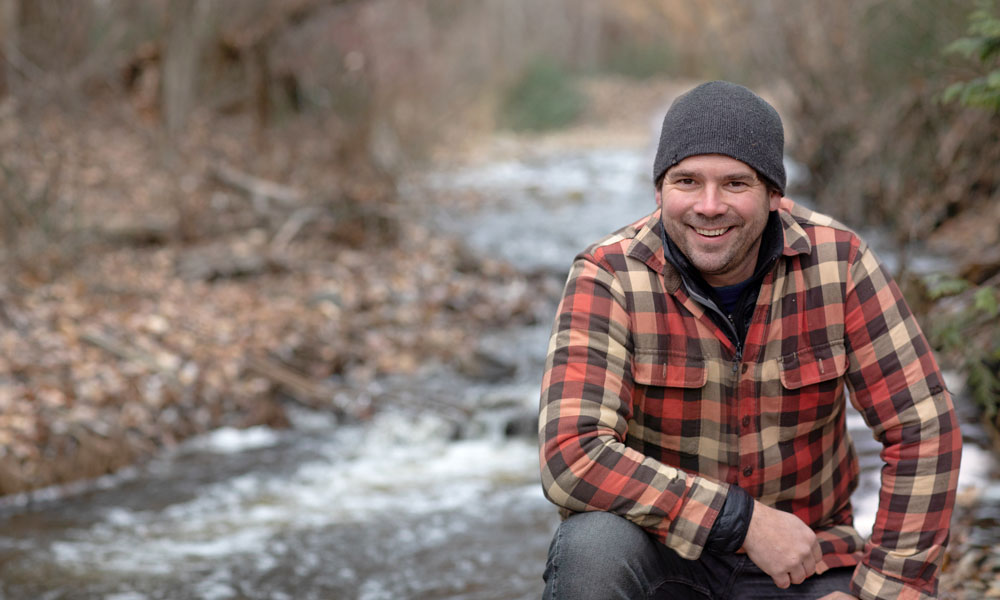Environment & Sustainability, Faculty Profile, People, Research, Science
Restoring nature’s broken links to help wildlife
April 16, 2024

About
Name
Adam Ford
Role
Associate Professor
Director, Okanagan Institute for Biodiversity, Resilience & Ecosystem Services (BRAES)
Canada Research Chair in Wildlife Restoration Ecology (Tier 2)
Program
Biology
Faculty
Irving K. Barber Faculty of Science
Campus
Okanagan (Kelowna, BC)
Education
Liber Ero Fellow, University of Guelph
PhD, UBC Vancouver
Master of Science, Carleton University
Bachelor of Science, University of Victoria
Hometown
Calgary, Alberta
“I can’t imagine anywhere else I’d rather be to do this work. I can look out my front door and know there are grizzly bears, elk migrations, wildfire… All the dynamics that go into our work are right here.”
When Dr. Adam Ford spots a mule deer meandering through a subdivision, he loves knowing not just what she eats, but where she spent the last summer and her routes through the Okanagan landscape. Most importantly, he loves knowing his research supports this deer’s very existence in BC.
It’s this kind of real-world impact that led Dr. Ford to be named UBC Okanagan’s 2024 Researcher of the Year in Natural Sciences and Engineering.
As the Canada Research Chair in Wildlife Restoration Ecology (Tier 2) and an Associate Professor in Biology, Dr. Ford leads the Wildlife Restoration Ecology (WiRE) Lab to explore how humans affect the predators and prey around them. His research ranges from minimizing human/bear conflict to understanding people’s opinions on ways to protect caribou.
While much of his work is focused on BC, a UBC Killam Accelerator Research Fellowship is helping expand Dr. Ford’s research in Kenya. Just as elk encounter human-made roadblocks from new cherry orchards in Kelowna, giraffes in Kenya face increased mango crops along the river, which block their drinking water and create conflict with humans when the giraffes eat the mangoes.
“It’s like two versions of the same story,” says Dr. Ford. “The questions in Kenya are very similar to what we’re doing here in BC.”

In southern British Columbia, cougars are understudied predators of declining mule deer and other large hooved mammals. As part of the Southern BC Cougar project, Dr. Ford and the team deployed GPS collars on 51 adult cougars and ear-marked 42 cougar kittens. Photo courtesy of Dr. Adam Ford.
His research often follows the lead of Indigenous conservation and restoration, like the West Moberly First Nations’ and Saulteau First Nations’ successful recovery of the Klinse-Za caribou population. Through actions like habitat protection and a maternal pen that allowed caribou to give birth away from predators, Dr. Ford’s lab found the herd grew from 30 caribou in 2013 to over 136 animals in 2023.
“The motivation and the leadership of the caribou recovery came from the communities. It was a huge privilege to be part of that work,” says Dr. Ford.
His engagement with communities and governmental organizations often leads to real-world impacts well before academic publications, like when he saw the threat of chronic wasting disease (CWD) entering BC through Alberta and Montana.
Sometimes called “zombie deer disease,” this fatal disease causes animals to become lethargic and waste away. CWD can spread through the deer family to caribou, already a threatened species in Canada. While not yet documented, there’s potential for CWD to jump the species barrier to humans through infected meat, similar to how mad cow disease has a human variant.
“There are huge implications for the spread of CWD in communities that are dependent on wild game, including many Indigenous communities and rural communities,” says Dr. Ford.

Here, Dr. Ford is seen tracking a Cape buffalo in Laikipia, Kenya. As part of his UBC Killam Accelerator Research Fellowship, Dr. Ford is building his research program with partners in the country. Photo courtesy of Dr. Adam Ford.
Upon seeing this risk, Dr. Ford was able to rapidly put together a study that identified gaps in provincial sampling where CWD could cross into BC undetected. They directly shared this report with the BC government, which changed the areas for mandatory deer testing as a result.
Unfortunately, the province did identify the first documented cases in BC in early 2024—in one of the same hot spots Dr. Ford’s lab predicted.
Dr. Ford points to funding and support from UBC Okanagan that helped him act so promptly, getting tracking collars out in the field as soon as they were needed.
“I can’t imagine anywhere else I’d rather be to do this work. I can look out my front door and know there are grizzly bears, elk migrations, wildfire… All the dynamics that go into our work are right here.”
He notes that his Researcher of the Year recognition is due to years of hard work from not just him, but everyone in the WiRE Lab.
“This award is testament to the hard work of my students and staff and the trust our partners have put in us. We’re tackling problems that matter to people, and we’re making a difference.”